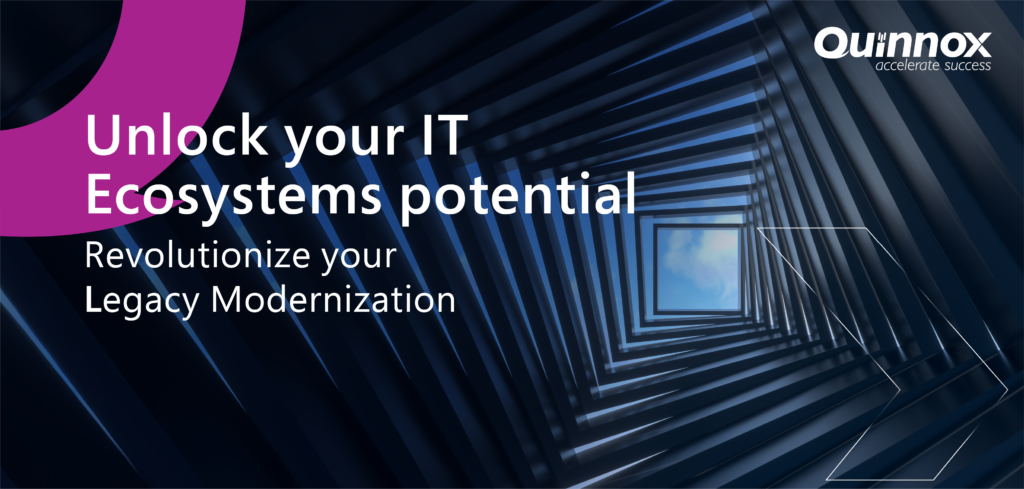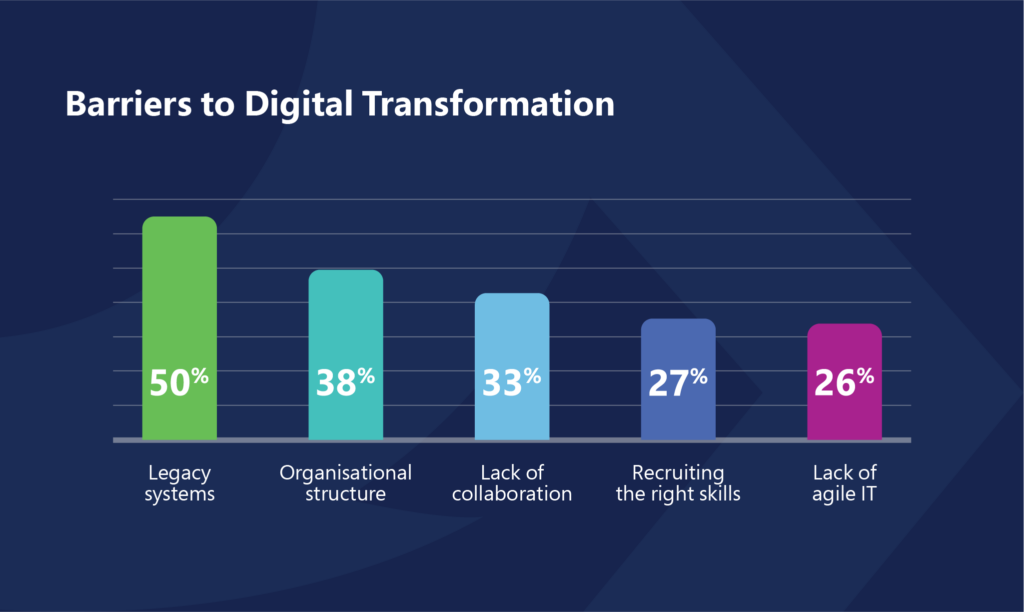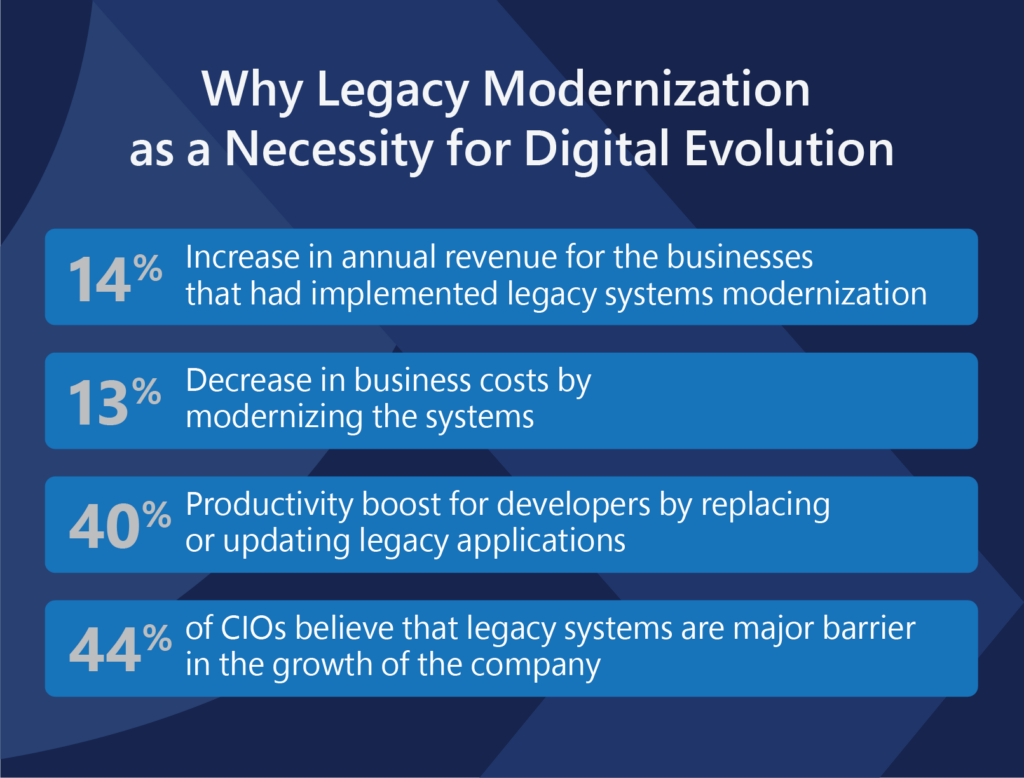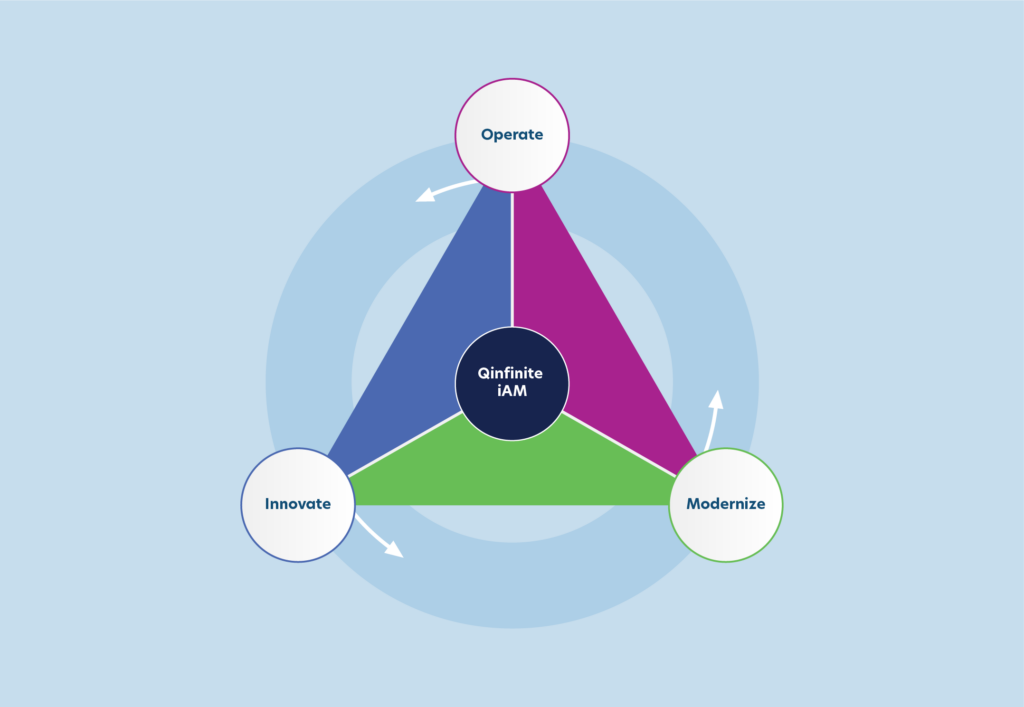Accelerate IT operations with AI-driven Automation
Automation in IT operations enable agility, resilience, and operational excellence, paving the way for organizations to adapt swiftly to changing environments, deliver superior services, and achieve sustainable success in today's dynamic digital landscape.
Driving Innovation with Next-gen Application Management
Next-generation application management fueled by AIOps is revolutionizing how organizations monitor performance, modernize applications, and manage the entire application lifecycle.
AI-powered Analytics: Transforming Data into Actionable Insights
AIOps and analytics foster a culture of continuous improvement by providing organizations with actionable intelligence to optimize workflows, enhance service quality, and align IT operations with business goals.

As technology continues to advance at an unprecedented rate, businesses are finding themselves at a crossroads—forced to choose between clinging to their legacy systems or embracing the future. Legacy systems, often built decades ago, were once the backbone of operations, designed for simpler times with less complexity. However, in today’s hyper-connected and data-driven world, these outdated infrastructures can become liabilities rather than assets.
The need to modernize legacy systems arise from the increasing pressure on businesses to stay competitive, agile, and secure. Legacy systems can create roadblocks in areas like data accessibility, integration with newer technologies, customer experience, and overall operational efficiency. Without modernization, businesses risk falling behind in an era where digital transformation is essential for survival.

Source: Information Age
This is where AI-powered legacy system transformation comes in. Qinfinite, with its innovative and proactive approach provides a seamless bridge between the past and the future, empowering businesses to thrive in a rapidly evolving digital world.
Why Legacy Modernization as a Necessity for Digital Evolution
Outdated systems often hinder scalability, innovation, and integration with newer digital tools, leaving businesses vulnerable to inefficiency and security risks. By modernizing legacy systems, organizations not only streamline operations but also unlock opportunities for greater agility, data-driven decision-making and customer-centric solutions. This transformation ensures they remain competitive in an increasingly digital world, allowing them to capitalize on emerging technologies and future-proof their operations.

Source: Data Science Central
How Qinfinite is Redefining Legacy System Modernization for the Digital Age

Quinnox’s intelligent application management (iAM) platform Qinfinite offers a comprehensive, AI-powered approach to legacy modernization that addresses these challenges head-on. Empowering enterprises to continuously operate, modernize, and innovate their applications, Qinfinite helps organizations remain agile and competitive in a rapidly evolving technological landscape, improving application performance and availability.
The process can be broken down into several key stages:
1. Understand and Assess
The first step is to gain a deep understanding of your current IT landscape. Qinfinite’s Discovery Platform and Knowledge Graph automate this process, reducing effort by 80% compared to manual inventory updates and improving accuracy by 90%.
2. Analyze and Prioritize
With a clear picture of your IT ecosystem, the next step is to analyze and prioritize modernization efforts. Qinfinite’s Business Impact Analysis and TIME Analysis tools help identify which applications should be targeted for modernization based on their business value and technical condition.
3. Plan and Simulate
Before embarking on modernization efforts, it’s crucial to understand the potential impacts. Qinfinite’s Simulation Experience allows for virtual impact analysis, reducing modernization risks by 40%.
4. Execute and Validate
During the modernization process, Qinfinite provides tools for Simulcast Validation, Synthetic Monitoring, and Integration Validation. These features can reduce effort in regression and performance testing by up to 50%.
5. Optimize and Govern
Post-modernization, Qinfinite’s Intelligent Incident Management and BizDevOps features help optimize operations, reducing Mean Time to Resolve (MTTR) by up to 70% and improving system availability by up to 40%.
Watch Webinar Now: Why Qinfinite is G.O.A.T of IT Operations?
The Benefits of AI-Powered Legacy Modernization
By leveraging AI and automation capabilities of Qinfinite throughout the legacy system migration process, organizations can reap significant benefits:
- Up to 60% reduction in Application Management Services (AMS) costs
- Up to 80% reduction in Mean Time to Resolve (MTTR)
- Improved Customer Satisfaction (CSAT) scores
- Up to 70% improvement in operational efficiency
In the Infinite Game of application management, you can’t rely on tools designed for finite goals. You need a platform that understands the ongoing nature of application management and compounds value over time. Qinfinite is that platform that has helped businesses achieve some great success numbers as listed below:
Overcoming Common Obstacles of Legacy Modernization
Legacy modernization is not without its challenges. Common obstacles include resistance to change, limited budgets, and concerns about business continuity. However, the Qinfinite approach addresses these issues by:
- Providing clear, data-driven insights to build a compelling case for modernization
- Offering flexible, incremental modernization strategies that align with budget constraints
- Utilizing simulation and validation tools to minimize risks to business continuity
Did you know? According to a report by Forrester, companies using cloud-based testing environments have reduced their testing costs by up to 45% while improving test coverage by 30%.
Conclusion: A New Era of Disaster Recovery Readiness
In an era where AI is reshaping the technology landscape and customer demands are constantly shifting, legacy modernization is no longer optional—it’s a necessity for staying competitive. By adopting a strategic, AI-powered approach to modernization, organizations can unlock the full potential of their IT ecosystems, driving innovation, efficiency, and growth.
The journey to modernization may seem daunting, but with the right tools and approach, it’s a journey that can transform your business for the digital age. As you embark on your modernization efforts, remember that it’s not just about updating technology—it’s about future-proofing your business and maximizing value through AI-powered operations.
Frequently Asked Questions (FAQs)
Legacy system modernization is the process of updating and improving outdated software, hardware, and IT infrastructure to better meet current business needs and technological standards. This often involves transforming legacy applications or systems to modern platforms, utilizing new technologies like cloud computing, microservices, and automation to enhance efficiency, scalability, and security.
Automating legacy system modernization involves using tools and techniques that streamline the transformation of old systems. This could include:
– Code Migration Tools: Automatically migrating legacy code to modern programming languages or frameworks.
– API Integration: Creating APIs to connect legacy systems with modern applications, enabling communication without a full overhaul.
– Cloud-based Solutions: Moving legacy systems to the cloud to enhance scalability and reduce maintenance efforts.
– Containerization: Packaging legacy applications in containers (like Docker) to make them portable and more easily integrated into modern environments.
– Low-code/no-code Platforms: Using these platforms to speed up the development of modern applications and reduce the manual work of migration.
– Improved Efficiency: Modern systems can perform tasks more quickly and reliably, reducing downtime and manual effort.
– Cost Savings: By transitioning to newer technologies (especially cloud-based solutions), organizations can reduce maintenance and infrastructure costs.
– Better Security: Modern systems come with updated security features, helping protect sensitive data and reducing vulnerabilities.
– Scalability: Newer systems are more flexible and can scale easily to accommodate growth, making them future-proof.
– Enhanced User Experience: Modern systems offer improved interfaces, making them easier to use for both employees and customers.
– Faster Innovation: With modernized systems, businesses can more easily integrate new technologies and adapt to changing market needs.
– High Costs: The initial investment in modernization, including the cost of tools, consulting, and infrastructure, can be significant.
– Complexity: Legacy systems may be highly complex or intertwined with other systems, making migration difficult and time-consuming.
– Resistance to Change: Employees and stakeholders might be resistant to the disruption caused by modernizing existing systems, especially if they’re used to the old way of doing things.
– Data Migration: Transferring data from legacy systems to modern platforms without losing integrity can be challenging.
– Integration Issues: Modernizing legacy systems often involves ensuring compatibility with existing business processes, systems, and external applications.
– Downtime Risks: The modernization process can introduce temporary downtime or disruptions, which might affect business operations.
– Conduct a Comprehensive Assessment: Evaluate the existing legacy systems to understand the scope of the problem, assess the risks, and define clear goals for modernization.
– Prioritize Systems: Modernize the most critical or outdated systems first, especially those with high operational or business impact.
– Use Agile Methodologies: Implement modernized solutions in smaller, manageable steps (incrementally) to minimize risk and ensure smooth transitions.
– Involve Stakeholders: Engage all relevant stakeholders early in the process, including IT teams, business leaders, and end users, to align the modernization efforts with business goals.
– Test Thoroughly: Regularly test the updated systems to ensure they meet business requirements, perform well, and don’t disrupt existing operations.
– Focus on Security: Modern systems must incorporate the latest security practices to protect against cyber threats.
– Leverage Automation Tools: Utilize tools for code refactoring, testing, and deployment to speed up the process and reduce human error.

